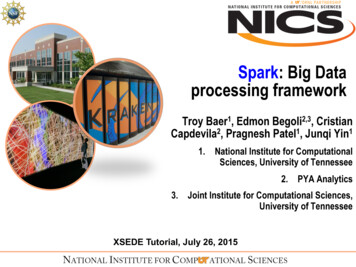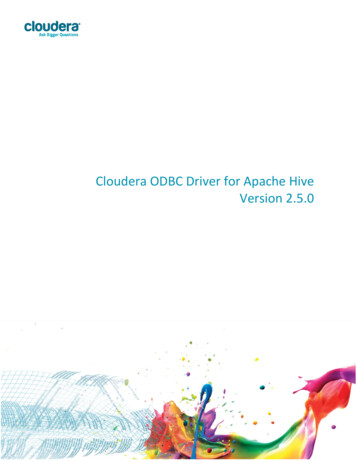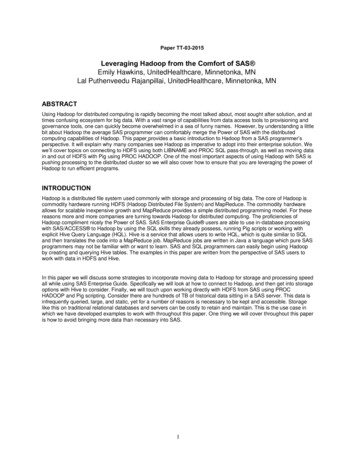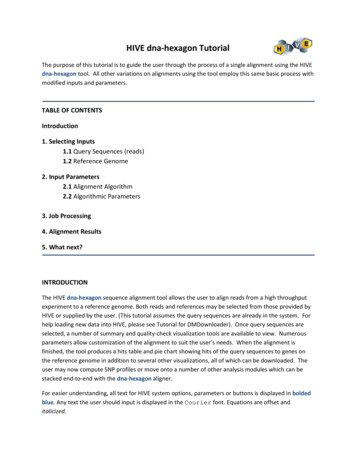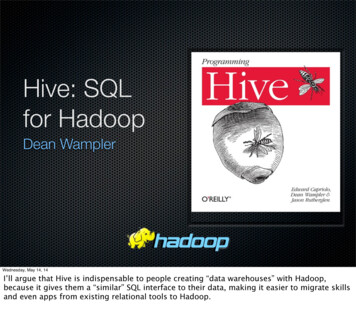
Transcription
hive#hive
Table of ContentsAbout1Chapter 1: Getting started with hive2Remarks2Examples2Word Count Example in Hive2Installation of Hive(linux)3Hive Installation with External Metastore in Linux4Chapter 2: Create Database and Table Statement7Syntax7Remarks8Examples8Create Table8Create Database9Hive ACID table creation.9HIVE HBASE Integration10Create table using existing table properties.10Chapter 3: Export Data in HiveExamplesExport feature in hiveChapter 4: File formats in AVRO13Text File13Chapter 5: Hive Table Creation Through Sqoop15Introduction15Remarks15Examples15
Hive import with Destination table name in hiveChapter 6: Hive User Defined Functions (UDF's)Examples151616Hive UDF creation16Hive UDF to trim the given string.16Chapter 7: Indexing18Examples18Structure18Chapter 8: Insert Statement19Syntax19Remarks19Examples20insert overwrite20Insert into table20Chapter 9: SELECT Statement21Syntax21Examples21Select All Rows21Select Specific Rows21Select: Project selected columns22Chapter 10: Table Creation Script with sample dataExamples2424Date and Timestamp types24Text Types24Numeric Types24Floating Point Numeric Types25Boolean and Binary Types25Note:Complex Types2525ARRAY25MAP26
STRUCT26UNIONTYPE26Chapter 11: User Defined Aggregate Functions (UDAF)28ExamplesUDAF mean exampleChapter 12: User Defined Table Functions (UDTF's)ExamplesUDTF Example and UsageCredits282830303033
AboutYou can share this PDF with anyone you feel could benefit from it, downloaded the latest versionfrom: hiveIt is an unofficial and free hive ebook created for educational purposes. All the content is extractedfrom Stack Overflow Documentation, which is written by many hardworking individuals at StackOverflow. It is neither affiliated with Stack Overflow nor official hive.The content is released under Creative Commons BY-SA, and the list of contributors to eachchapter are provided in the credits section at the end of this book. Images may be copyright oftheir respective owners unless otherwise specified. All trademarks and registered trademarks arethe property of their respective company owners.Use the content presented in this book at your own risk; it is not guaranteed to be correct noraccurate, please send your feedback and corrections to info@zzzprojects.comhttps://riptutorial.com/1
Chapter 1: Getting started with hiveRemarks Hive is a data warehouse tool built on top of Hadoop. It provides an SQL-like language to query data. We can run almost all the SQL queries in Hive, the only difference, is that, it runs a mapreduce job at the backend to fetch result from Hadoop Cluster. Because of this Hivesometimes take more time to fetch the result-set.ExamplesWord Count Example in HiveDocs file (Input File)Mary had a little lambits fleece was white as snowand everywhere that Mary wentthe lamb was sure to go.Hive QueryCREATE TABLE FILES (line STRING);LOAD DATA INPATH 'docs' OVERWRITE INTO TABLE FILES;CREATE TABLE word counts ASSELECT word, count(1) AS count FROM(SELECT explode(split(line, ' ')) AS word FROM FILES) wGROUP BY wordORDER BY word;Output of word counts table in torial.com/2
t,1went,1the,1sure,1to,1go,1Installation of Hive(linux)Start by downloading the latest stable release from https://hive.apache.org/downloads.html- Now untar the file with tar -xvf hive-2.x.y-bin.tar.gz- Create a directory in the /usr/local/ with sudo mkdir /usr/local/hive- Move the file to root with mv /Downloads/hive-2.x.y /usr/local/hive- Edit environment variablesfor hadoop and hive in .bashrc gedit /.bashrclike thisexport HIVE HOME /usr/local/hive/apache-hive-2.0.1-bin/export PATH PATH: HIVE HOME/binhttps://riptutorial.com/3
export CLASSPATH CLASSPATH:/usr/local/Hadoop/lib/*:.export CLASSPATH b/*:.- Now, start hadoop if it is not already running. And make sure that it is running and it is not insafe mode. hadoop fs -mkdir /user/hive/warehouseThe directory "warehouse" is the location to store the table or data related to hive. hadoop fs -mkdir /tmpThe temporary directory “tmp” is the temporary location to store the intermediate result ofprocessing.- Set Permissions for read/write on those folders. hadoop fs -chmod g w /user/hive/warehouse hadoop fs -chmod g w /user/tmp- Now fire up HIVE with this command in console hiveHive Installation with External Metastore in LinuxPre-requisites:1. Java 72. Hadoop (Refer here for Hadoop Installation)3. Mysql Server and ClientInstallation:Step 1: Download the latest Hive tarball from the downloads page.Step 2: Extract the downloaded tarball (Assumption: The tarball is downloaded in HOME)tar -xvf /home/username/apache-hive-x.y.z-bin.tar.gzStep 3: Update the environment file ( /.bashrc)export HIVE HOME /home/username/apache-hive-x.y.z-binexport PATH HIVE HOME/bin: PATHsource the file to set the new environment variables.source /.bashrchttps://riptutorial.com/4
Step 4: Download the JDBC connector for mysql from here and extract it.tar -xvf mysql-connector-java-a.b.c.tar.gzThe extracted directory contains the connector jar file mysql-connector-java-a.b.c.jar. Copy it tothe lib of HIVE HOMEcp mysql-connector-java-a.b.c.jar HIVE HOME/lib/Configuration:Create the hive configuration file hive-site.xml under HIVE HOME/conf/ directory and add thefollowing metastore related properties. configuration property name javax.jdo.option.ConnectionURL /name value jdbc:mysql://localhost/hive meta /value description JDBC connect string for a JDBC metastore /description /property property name javax.jdo.option.ConnectionDriverName /name value com.mysql.jdbc.Driver /value description Driver class name for a JDBC metastore /description /property property name javax.jdo.option.ConnectionUserName /name value mysqluser /value description username to use against metastore database /description /property property name javax.jdo.option.ConnectionPassword /name value mysqlpass /value description password to use against metastore database /description /property property name datanucleus.autoCreateSchema /name value false /value /property property name datanucleus.fixedDatastore /name value true /value /property /configuration Update the values of MySQL "username" and "password" accordingly in the properties.Create the Metastore Schema:The metastore schema scripts are available under HIVE torial.com/5
Login to MySQL and source the schema,mysql -u username -ppasswordmysql mysql mysql mysql create database hive meta;use hive meta;source hive-schema-x.y.z.mysql.sql;exit;Starting Metastore:hive --service metastoreTo run it in background,nohup hive --service metastore &Starting HiveServer2: (Use if required)hiveserver2To run it in background,nohup hiveserver2 metastore &Note: These executables are available under HIVE HOME/bin/Connect:Use either hive, beeline or Hue to connect with Hive.Hive CLI is deprecated, using Beeline or Hue is recommended.Additional Configurations for Hue:Update this value in HUE HOME/desktop/conf/hue.ini[beeswax]hive conf dir /home/username/apache-hive-x.y.z-bin/confRead Getting started with hive online: arted-withhivehttps://riptutorial.com/6
Chapter 2: Create Database and TableStatementSyntax CREATE [TEMPORARY] [EXTERNAL] TABLE [IF NOT EXISTS] [db name.]table name[(col name data type [COMMENT col comment], .)] [COMMENT table comment][PARTITIONED BY (col name data type [COMMENT col comment], .)] [CLUSTERED BY(col name, col name, .) [SORTED BY (col name [ASC DESC], .)] INTO num bucketsBUCKETS] [SKEWED BY (col name, col name, .) -- (Note: Available in Hive 0.10.0 andlater)] ON ((col value, col value, .), (col value, col value, .), .) [STORED ASDIRECTORIES] [ [ROW FORMAT row format] [STORED AS file format] STORED BY'storage.handler.class.name' [WITH SERDEPROPERTIES (.)] ] [LOCATION hdfs path][TBLPROPERTIES (property name property value, .)][AS select statement]; CREATE [TEMPORARY] [EXTERNAL] TABLE [IF NOT EXISTS] [db name.]table nameLIKE existing table or view name [LOCATION hdfs path]; data type : primitive type,array type,map type,struct type,union type primitive type: TINYINT, SMALLINT, INT , BIGINT, BOOLEAN, FLOAT, DOUBLE, STRING,BINARY, TIMESTAMP, DECIMAL, DECIMAL(precision, scale), DATE, VARCHAR, CHAR array type: ARRAY data type map type: MAP primitive type, data type struct type: STRUCT col name : data type [COMMENT col comment], . union type: UNIONTYPE data type, data type, . row format: DELIMITED [FIELDS TERMINATED BY char [ESCAPED BY char]][COLLECTION ITEMS TERMINATED BY char] [MAP KEYS TERMINATED BY char] [LINESTERMINATED BY char] [NULL DEFINED AS char], SERDE serde name [WITH SERDEPROPERTIES (property name property value,property name property value, .)] file format: : SEQUENCEFILE , TEXTFILE , RCFILE , ORC , PARQUET , AVRO ,INPUTFORMAT input format classname OUTPUTFORMAT output format classname CREATE (DATABASE SCHEMA) [IF NOT EXISTS] database name [COMMENTdatabase comment] [LOCATION hdfs path] [WITH DBPROPERTIES(property name property value, .)];https://riptutorial.com/7
RemarksWhen working with tables and databases in HIVE. Below points can be usefull. We can switch database using use database; commandTo know the current working database we can get using SELECT current database()To see the DDL used for create table statement we can use SHOW CREATE TABLE tablenameTo see all columns of table use DESCRIBE tablename to show extended details like locationserde used and others DESCRIBE FORMATTED tablename. DESCRIBE can also be abbrevated asDESC.ExamplesCreate TableCreating a managed table with partition and stored as a sequence file. The data format in the filesis assumed to be field-delimited by Ctrl-A ( A) and row-delimited by newline. The below table iscreated in hive warehouse directory specified in value for the key hive.metastore.warehouse.dir inthe Hive config file hive-site.xml.CREATE TABLE view(time INT,id BIGINT,url STRING,referrer url STRING,add STRING COMMENT 'IP of the User')COMMENT 'This is view table'PARTITIONED BY(date STRING, region STRING)ROW FORMAT DELIMITEDFIELDS TERMINATED BY '\001'STORED AS SEQUENCEFILE;Creating a external table with partitions and stored as a sequence file. The data format in the filesis assumed to be field-delimited by ctrl-A and row-delimited by newline. The below table iscreated in the location specified and it comes handy when we already have data. One of theadvantages of using an external table is that we can drop the table without deleting the data. Forinstance, if we create a table and realize that the schema is wrong, we can safely drop the tableand recreate with the new schema without worrying about the data.Other advantage is that if weare using other tools like pig on same files, we can continue using them even after we delete thetable.CREATE EXTERNAL TABLE view(time INT,id BIGINT,url STRING,referrer url STRING,add STRING COMMENT 'IP of the User')COMMENT 'This is view table'PARTITIONED BY(date STRING, region STRING)ROW FORMAT DELIMITEDhttps://riptutorial.com/8
FIELDS TERMINATED BY '\001'STORED AS SEQUENCEFILELOCATION ' hdfs location ';Creating a table using select query and populating results from query, these statements are knownas CTAS(Create Table As Select).There are two parts in CTAS, the SELECT part can be any SELECT statement supported byHiveQL. The CREATE part of the CTAS takes the resulting schema from the SELECT part andcreates the target table with other table properties such as the SerDe and storage format.CTAS has these restrictions: The target table cannot be a partitioned table. The target table cannot be an external table. The target table cannot be a list bucketing table.CREATE TABLE new key value storeROW FORMAT SERDE rDe"STORED AS RCFileASSELECT * FROM page viewSORT BY url, add;Create Table Like:The LIKE form of CREATE TABLE allows you to copy an existing table definition exactly (withoutcopying its data). In contrast to CTAS, the statement below creates a new table whose definitionexactly matches the existing table in all particulars other than table name. The new table containsno rows.CREATE TABLE empty page viewsLIKE page views;Create DatabaseCreating a database in a particular location. If we dont specify any location for database itscreated in warehouse directory.CREATE DATABASE IF NOT EXISTS db nameCOMMENT 'TEST DATABASE'LOCATION /PATH/HDFS/DATABASE/;Hive ACID table creation.ACID tables are supported since hive 0.14 version. Below table supportsUPDATE/DELETE/INSERTBelow configuration changes required in hive-site.xml.https://riptutorial.com/9
hive.support.concurrency truehive.enforce.bucketing truehive.exec.dynamic.partition.mode nonstricthive.txn.manager .compactor.initiator.on truehive.compactor.worker.threads 1Currently only orc file is format supported.Table create statement.create table Sample Table(col1 Int,col2 String,col3 String)clustered by (col3) into 3 bucketsstored as orcTBLPROPERTIES ('transactional' 'true');HIVE HBASE IntegrationHive-Hbase integration is supported since below versions. Hive: 0.11.0 HBase: 0.94.2 Hadoop:0.20.2CREATE TABLE hbase hive(id string,col1 string,col2 string,col3 int)STORED BY WITH SERDEPROPERTIES("hbase.columns.mapping" ":key,cf1:col1,cf1:col2,cf1:col3")TBLPROPERTIES ("hbase.table.name" "hive hbase");Note: 1st column should be the key column.Create table using existing table properties.CREATE TABLE new table name LIKE existing table name;Read Create Database and Table Statement online: base-and-table-statementhttps://riptutorial.com/10
Chapter 3: Export Data in HiveExamplesExport feature in hiveExporting data from employees table to /tmp/ca employeesINSERT OVERWRITE LOCAL DIRECTORY '/tmp/ca employees' SELECT name, salary, addressFROM employees WHERE se.state 'CA';Exporting data from employees table to multiple local directories based on specificconditionThe below query shows how a single construct can be used to export data to multiple directoriesbased on specific criteriaFROM employees se INSERT OVERWRITE DIRECTORY '/tmp/or employees' SELECT * WHERE se.cty 'US'and se.st 'OR'INSERT OVERWRITE DIRECTORY '/tmp/ca employees' SELECT * WHERE se.cty 'US' and se.st 'CA'INSERT OVERWRITE DIRECTORY '/tmp/il employees' SELECT * WHERE se.cty 'US' and se.st 'IL';Read Export Data in Hive online: a-in-hivehttps://riptutorial.com/11
Chapter 4: File formats in HIVEExamplesSEQUENCEFILEStore data in SEQUENCEFILE if the data needs to be compressed. You can import text filescompressed with Gzip or Bzip2 directly into a table stored as TextFile. The compression will bedetected automatically and the file will be decompressed on-the-fly during query execution.CREATE TABLE raw sequence (line STRING)STORED AS SEQUENCEFILE;ORCThe Optimized Row Columnar (ORC) file format provides a highly efficient way to store Hive data.It was designed to overcome limitations of the other Hive file formats. Using ORC files improvesperformance when Hive is reading, writing, and processing data. ORC file can contain lightweightindexes and bloom filters.See: anguageManual ORCORC is a recommended format for storing data within HortonWorks distribution.CREATE TABLE tab orc (col1 STRING,col2 STRING,col3 STRING)STORED AS ORCTBLPROPERTIES ("orc.compress" "SNAPPY","orc.bloom.filter.columns" "col1","orc.create.index" "true")To modify a table so that new partitions of the table are stored as ORC files:ALTER TABLE T SET FILEFORMAT ORC;As of Hive 0.14, users can request an efficient merge of small ORC files together by issuing aCONCATENATE command on their table or partition. The files will be merged at the stripe level withoutreserializatoin.ALTER TABLE T [PARTITION partition spec] CONCATENATE;PARQUETParquet columnar storage format in Hive 0.13.0 and later. Parquet is built from the ground up withhttps://riptutorial.com/12
complex nested data structures in mind, and uses the record shredding and assembly algorithmdescribed in the Dremel paper. We believe this approach is superior to simple flattening of nestedname spaces.Parquet is built to support very efficient compression and encoding schemes. Multiple projectshave demonstrated the performance impact of applying the right compression and encodingscheme to the data. Parquet allows compression schemes to be specified on a per-column level,and is future-proofed to allow adding more encodings as they are invented and implemented.Parquet is recommended File Format with Impala Tables in Cloudera distributions.See: ATE TABLE parquet table name (x INT, y STRING) STORED AS PARQUET;AVROAvro files are been supported in Hive 0.14.0 and later.Avro is a remote procedure call and data serialization framework developed within Apache'sHadoop project. It uses JSON for defining data types and protocols, and serializes data in acompact binary format. Its primary use is in Apache Hadoop, where it can provide both aserialization format for persistent data, and a wire format for communication between Hadoopnodes, and from client programs to the Hadoop services.Specification of AVRO format: https://avro.apache.org/docs/1.7.7/spec.htmlCREATE TABLE kstPARTITIONED BY (ds string)STORED AS AVROTBLPROPERTIES ('avro.schema.url' 'http://schema provider/kst.avsc');We can also use below syntax without using schema file.CREATE TABLE kst (field1 string, field2 int)PARTITIONED BY (ds string)STORED AS AVRO;In the examples above STOREDAS AVROclause is equivalent to:ROW FORMAT 'STORED AS p.hive.ql.io.avro.AvroContainerOutputFormat'Text Filehttps://riptutorial.com/13
TextFile is the default file format, unless the configuration parameter hive.default.fileformat has adifferent setting. We can create a table on hive using the field names in our delimited text file. Letssay for example, our csv file contains three fields (id, name, salary) and we want to create a tablein hive called "employees". We will use the below code to create the table in hive.CREATE TABLE employees (id int, name string, salary double) ROW FORMAT DELIMITED FIELDSTERMINATED BY ‘,’;Now we can load a text file into our table:LOAD DATA LOCAL INPATH '/home/ourcsvfile.csv' OVERWRITE INTO TABLE employees;Displaying the contents of our table on hive to check if the data was successfully loaded:SELECT * FROM employees;Read File formats in HIVE online: ts-in-hivehttps://riptutorial.com/14
Chapter 5: Hive Table Creation ThroughSqoopIntroductionIf we have a Hive meta-store associated with our HDFS cluster, Sqoop can import the data intoHive by generating and executing a CREATE TABLE statement to define the data’s layout in Hive.Importing data into Hive is as simple as adding the --hive-import option to your Sqoop commandline.RemarksImporting data directly from RDBMS to HIVE can solve lots of time. Also we can run a freeformquery(a join or some simple query) and populate it in a table of our choice directly into Hive.--hive-import tells Sqoop that the final destination is Hive and not HDFS.--hive-table option helps in importing the data to the table in hive chosen by us,otherwise it will be named as the source table being imported from RDBMS.ExamplesHive import with Destination table name in hive sqoop import --connect jdbc:mysql://10.0.0.100/hadooptest--username hadoopuser -P--table table name --hive-import --hive-table hive table nameRead Hive Table Creation Through Sqoop online: -creation-through-sqoophttps://riptutorial.com/15
Chapter 6: Hive User Defined Functions(UDF's)ExamplesHive UDF creationTo create a UDF, we need to extend UDF (org.apache.hadoop.hive.ql.exec.UDF) class andimplement evaluate method.Once UDF is complied and JAR is build, we need to add jar to hive context to create atemporary/permanent function.import org.apache.hadoop.hive.ql.exec.UDF;class UDFExample extends UDF {public String evaluate(String input) {return new String("Hello " input);}}hive ADD JAR JAR NAME .jar;hive CREATE TEMPORARY FUNCTION helloworld as 'package.name.UDFExample';hive select helloworld(name) from test;Hive UDF to trim the given string.package MyHiveUDFs;import org.apache.commons.lang.StringUtils;import org.apache.hadoop.hive.ql.exec.UDF;import org.apache.hadoop.io.Text;public class Strip extends UDF {private Text result new Text();public Text evaluate(Text str) {if(str null) {return );return result;}}export the above to jar fileGo to the Hive CLI and Add the UDF JARhttps://riptutorial.com/16
hive ADD jar /home/cloudera/Hive/hive udf trim.jar;Verify JAR is in Hive CLI Classpathhive list jars;/home/cloudera/Hive/hive udf trim.jarCreate Temporary Functionhive CREATE TEMPORARY FUNCTION STRIP AS 'MyHiveUDFs.Strip';UDF Outputhive select strip('OKhiveUDFhiveUDF ') from dummy;Read Hive User Defined Functions (UDF's) online: efined-functions--udf-s-https://riptutorial.com/17
Chapter 7: IndexingExamplesStructureCREATE INDEX index nameON TABLE base table name (col name, .)AS 'index.handler.class.name'[WITH DEFERRED REBUILD][IDXPROPERTIES (property name property value, .)][IN TABLE index table name][PARTITIONED BY (col name, .)][[ ROW FORMAT .] STORED AS . STORED BY .][LOCATION hdfs path][TBLPROPERTIES (.)]Example:CREATE INDEX inedx salary ON TABLE employee(salary) IndexHandler' WITH DEFERRED REBUILD;Alter IndexALTER INDEX index name ON table name [PARTITION (.)] REBUILDDrop IndexDROP INDEX index name ON table name If WITH DEFERRED REBUILD is specified on CREATE INDEX, then the newly created index isinitially empty (regardless of whether the table contains any data).The ALTER INDEX REBUILD command can be used to build the index structure for all partitionsor a single partition.Read Indexing online: tps://riptutorial.com/18
Chapter 8: Insert StatementSyntax Standard syntax: INSERT OVERWRITE TABLE tablename1 [PARTITION (partcol1 val1, partcol2 val2 .) [IFNOT EXISTS]] select statement1 FROM from statement; INSERT INTO TABLE tablename1 [PARTITION (partcol1 val1, partcol2 val2 .)]select statement1 FROM from statement; INSERT INTO TABLE tablename1 [PARTITION (partcol1 val1, partcol2 val2 .)] (z,y)select statement1 FROM from statement; Hive extension (multiple inserts): FROM from statementINSERT OVERWRITE TABLE tablename1 [PARTITION (partcol1 val1, partcol2 val2 .) [IFNOT EXISTS]] select statement1[INSERT OVERWRITE TABLE tablename2 [PARTITION . [IF NOT EXISTS]]select statement2][INSERT INTO TABLE tablename2 [PARTITION .] select statement2] .; FROM from statementINSERT INTO TABLE tablename1 [PARTITION (partcol1 val1, partcol2 val2 .)]select statement1[INSERT INTO TABLE tablename2 [PARTITION .] select statement2][INSERT OVERWRITE TABLE tablename2 [PARTITION . [IF NOT EXISTS]]select statement2] .; Hive extension (dynamic partition inserts): INSERT OVERWRITE TABLE tablename PARTITION (partcol1[ val1], partcol2[ val2] .)select statement FROM from statement; INSERT INTO TABLE tablename PARTITION (partcol1[ val1], partcol2[ val2] .)select statement FROM from statement;Remarksinsert overwriteAn insert overwrite statement deletes any existing files in the target table or partition before addingnew files based off of the select statement used. Note that when there are structure changes to atable or to the DML used to load the table that sometimes the old files are not deleted. Whenloading to a table using dynamic partitioning only partitions defined by the select statement will behttps://riptutorial.com/19
overwritten. Any preexisting partitions in the target will remain and will not be deleted.insert intoAn insert into statement appends new data into a target table based off of the select statementused.Examplesinsert overwriteinsert overwrite table yourTargetTable select * from yourSourceTable;Insert into tableINSERT INTO will append to the table or partition, keeping the existing data intact.INSERT INTO table yourTargetTable SELECT * FROM yourSourceTable;If a table is partitioned then we can insert into that particular partition in static fashion as shownbelow.INSERT INTO TABLE yourTargetTable PARTITION (state CA, city LIVERMORE)select * FROM yourSourceTable;If a table is partitioned then we can insert into that particular partition in dynamic fashion as shownbelow. To perfom dynamic partition inserts we must set below below properties.Dynamic Partition inserts are disabled by default. These are the relevant configurationproperties for dynamic partition inserts:SET hive.exec.dynamic.partition true;SET hive.exec.dynamic.partition.mode non-strictINSERT INTO TABLE yourTargetTable PARTITION (state CA, city LIVERMORE) (date,time)select * FROM yourSourceTable;Multiple Inserts into from a table.Hive extension (multiple inserts):FROM table nameINSERT OVERWRITE TABLE table one SELECT table name.column one,table name.column twoINSERT OVERWRITE TABLE table two SELECT table name.column two WHERE table name.column one 'something'Read Insert Statement online: tementhttps://riptutorial.com/20
Chapter 9: SELECT StatementSyntax SELECT [ALL DISTINCT] select expr, select expr, select expr, .FROM table reference[WHERE where condition][GROUP BY col list][HAVING having condition][ORDER BY col list][LIMIT n]ExamplesSelect All Rowsis used to retrieve rows of data from a table. You can specify which columns will beretrieved:SELECTSELECT Name, PositionFROM Employees;Or just use * to get all columns:SELECT *FROM Employees;Select Specific RowsThis query will return all columns from the table sales where the values in the column amount isgreater than 10 and the data in the region column in "US".SELECT * FROM sales WHERE amount 10 AND region "US"You can use regular expressions to select the columns you want to obtain. The followingstatement will get the data from column name and all the columns starting with the prefix address.SELECT name, address.* FROM EmployeesYou can also use the keyword LIKE (combined with the character '%') to match strings that beginwith or end with a particular substring. The following query will return all the rows where thecolumn city begins with "New"SELECT name, city FROM Employees WHERE city LIKE 'New%'https://riptutorial.com/21
You can use the keyword RLIKE to use Java regular expressions. The following query will returnrows which column name contains the words "smith" or "son".SELECT name, address FROM Employee WHERE name RLIKE '.*(smith son).*'You can apply functions to the returned data. The following sentence will return all name in uppercase.SELECT upper(name) FROM EmployeesYou can use different mathematical functions , collection functions, type conversion functions, datefunctions, conditional functions or string functions.In order to limit the number of rows given in result, you can use the LIMIT keyword. The followingstatement will return only ten rows.SELECT * FROM Employees LIMIT 10Select: Project selected columnsSample table (say Employee) structureColumn NameDatatypeIDINTF NameSTRINGL NameSTRINGPhoneSTRINGAddressSTRINGProject all the columnsUse wild card * to project all the columns. e.g.Select * from EmployeeProject selected columns (say ID, Name)Use name of columns in the projection list. e.g.Select ID, Name from EmployeeDiscard 1 column from Projection listhttps://riptutorial.com/22
Display all columns except 1 column. e.g.Select (ID)? . from EmployeeDiscard columns matching patternReject all columns which matches the pattern. e.g. Reject all the columns ending with NAMESelect (.*NAME )? . from EmployeeRead SELECT Statement online: tementhttps://riptutorial.com/23
Chapter 10: Table Creation Script withsample dataExamplesDate and Timestamp typesCREATE TABLE all datetime types(c date date,c timestamp timestamp);Minimum and maximum data values:insert into all datetime types values ('0001-01-01','0001-01-01 00:00:00.000000001');insert into all datetime types values ('9999-12-31','9999-12-31 23:59:59.999999999');Text TypesCREATE TABLE all text types(c char char(255),c varchar varchar(65535),c string string);Sample data:insert into all text type values ('some ****&&&%%% char value ','some #####@@@@ varcharvalue','some !! string value' );Numeric TypesCREATE TABLE all numeric types(c tinyint tinyint,c smallint smallint,c int int,c bigint bigint,c decimal decimal(38,3));Minimum and maximum data values:insert into all numeric types values 9999999999999999999999999999999.999);insert into all numeric types tutorial.com/24
Floating Point Numeric TypesCREATE TABLE all floating numeric types(c float float,c double double);Minimum and maximum data values:insertinsertinsertinsertintointointointoall floating numeric typesall floatin
Hive is a data warehouse tool built on top of Hadoop. It provides an SQL-like language to query data. We can run almost all the SQL queries in Hive, the only difference, is that, it runs a map-

